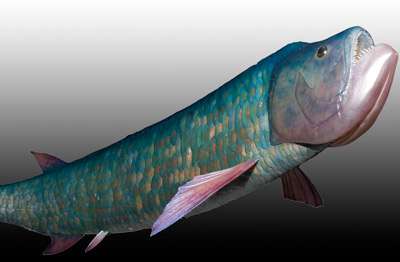Isisford Bulldog fish emerges from 100-million-year slumber

The Isisford bulldog fish, which surfaced from a 100 million year slumber eight years ago, will make its public debut at the Outer Barcoo Interpretation Centre in Isisford tomorrow (Saturday 20 April).
The Central Western Queensland fossilised fish was unearthed in a 2005 dig led by The University of Queensland's Dr Steve Salisbury.
The fossil of the large, fast-swimming predatory fish is estimated to be between 103 and 100 million years old, and belongs to a group of fishes known as ichthyodectiforms.
Ichthyodectiforms are an extinct group of fishes that were a common element of shallow marine fish faunas during the latter part of the Age of Dinosaurs.
Their large, upward opening jaws and jagged teeth have led them to be commonly referred to as 'bulldog fish'.
UQ's School of Biological Sciences researcher, Mr Kerry Geddes, said the fossil was entombed in a single nodule of sandstone, close to where the skull of Isisfordia duncani, the world's first modern crocodilian, was found.
"I decided to hit the nodule with my hammer and was surprised to find the preserved near-perfect skull and front half of the body," Mr Geddes said.
"We estimate the fish to have been just under a metre long."
UQ's School of Biological Sciences graduate Rodney Berrell prepared and studied the fossil.
"Preparation of the fossil took about six months using a combination of drilling and diluted acetic acid to gradually expose the delicate bones," he said.
Based on comparisons with other fossilised and living fishes, Mr Berrell and experts from Mexico and Japan, surmise this specimen belongs to a type of ichthyodectiform known as Cladocyclus.
"The Isisford fossil represents the first record of Cladocyclus in Australia, and indicates that species of this fish also inhabited freshwater environments," Mr Berrell said.
Zoologist and paleontologist Dr Steven Salisbury also studied the bones.
"It is likely that the Isisford bulldog fish travelled up river to Isisford from the contracting Eromanga Sea, which was probably still open to the north through the Gulf of Carpentaria when the Isisford fossils were deposited," he said.
"Together with the crocodilians found previously, these fishes are helping us piece together aspects of the unique fauna that inhabited this part of Queensland during the later part of the Age of Dinosaurs," Dr Salisbury said.
Provided by University of Queensland


















